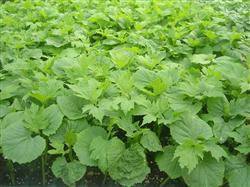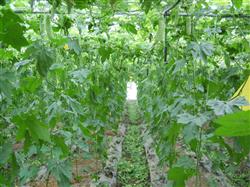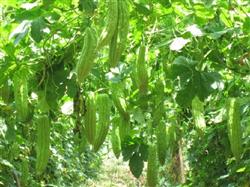How to plant grafted seedlings of balsam pear?

How to plant grafted seedlings of balsam pear? Please give a detailed introduction to balsam pear grafted seedling cultivation can refer to the following methods: first, select suitable rootstocks and scions and choose melon varieties with good affinity and strong stress resistance as rootstocks. At present, Yunnan black seed pumpkin and local grinding plate pumpkin are suitable. Scion varieties are generally selected by local landlords, such as "Longdu balsam pear No. 1", Damazi balsam pear and local Dabai balsam pear bred by Zigong Agricultural Science Institute. Second, soaking seeds, preparing nutritious soil, sowing seeds at the right time. 1. Soaking seeds: break the selected shells of balsam pear before sowing, and be careful not to hurt the kernels. Then the seeds of balsam pear and pumpkin were soaked in warm soup, soaked in hot water of 55-60 ℃, and stirred constantly to make the seeds heated evenly. After 10-20 minutes, wait for the water temperature to drop to about 30% to continue soaking, balsam pear seeds are generally soaked for 8-10 hours, pumpkin seeds are soaked for 8 hours, then wash off the mucus with clean water, soak them, pick them up, spread them in a porcelain plate, cover them with a double-layer wet cloth, and put them into a 28-32 ℃ incubator to accelerate germination. If there is no thermostat, you can use an electric blanket to promote germination, during which the seeds should be taken out and washed 1-2 times a day to wash off the liquid and promote germination. The seeds can be sown after germination. 2. Preparation of nutrient soil: a nutrition bowl must be used for pumpkin sowing and breeding. The preparation of nutrition soil is to mix the soil which has not been planted for many years with rotten barnyard manure or compost according to the proportion of 3:1. 50kg of mature human and animal manure and 1.0kg of calcium superphosphate are added to each cubic meter of nutrient soil, and sprayed with 50 times of formalin or mixed with 100g carbendazim or 200g chlorothalonil. Covered with thin film for 10-15 days, let it be fully fermented and sterilized, spread out and dry for 7 days, then load into a nutrition bowl. Pure land should be used for sowing and raising seedlings of balsam pear to prevent diseases at seedling stage. 3. Sowing at the right time: according to the climatic characteristics of Zigong for many years and the cultivation habits of farmers, it is generally better to sow before waking. If sowing and raising seedlings in advance, seedlings should be raised in electric hotbed or soil hotbed, and pumpkin should be sowed 3-5 days earlier than balsam pear. Third, timely grafting and strengthening the management of grafted seedlings can be grafted when pumpkins grow true (heart) leaves and balsam pear seedlings grow to one leaf with one heart. Cloudy, windless and humid weather are the most suitable for grafting. Before grafting, the seedbed should be watered properly. The methods of grafting are top insertion and needle grafting. The top insertion method first prepares two small bamboo sticks that are 8 cm long, 0.5 cm wide and 0.25 cm thick, and cuts one end of the bamboo stick to grow a small slope of about 1 cm. When grafting, the true leaves of pumpkin are cut off with a grafting blade, then the bamboo stick is obliquely inserted at the top of cotyledons in the same direction as cotyledons, the hypocotyls of balsam pear are cut into wedges, the bamboo sticks inserted in rootstocks are pulled out, and the hypocotyls of balsam pear are inserted into the section of pumpkin. Finally, it is fixed with a grafting clip. In the needle grafting method, the true leaves of pumpkin are cut off and flattened with a grafting blade, and then the hypocotyls of balsam pear are cut off, then one end of the grafting needle is inserted into the hypocotyls of balsam pear, and the other end is inserted into the top of the cotyledons of pumpkin seedlings. It is required that the plane of the hypocotyls of bitter gourd seedlings should be in contact with the top of the cotyledons of pumpkin seedlings as far as possible, and finally fixed with grafting clips. Grafting should be covered while grafting, and after grafting, shading treatment should be carried out with black film. The next 1-3 days should be covered with shade, heat preservation and moisturizing all day, then shaded from 10:00 to 3 p.m. every day according to weather conditions, and transparent in the rest of the day; the temperature in the small arch shed should be controlled at 32 ℃ during the day, 20 ℃ at night, and the humidity should be controlled at about 90%. See the light all day after 7 days, and gradually carry out the treatment of ventilation and cooling seedlings, keeping the temperature at 25 ℃ in the daytime and 15% at night. After 10-15 days of grafting, the grafting clip was removed and managed according to the general seedbed. After the grafted seedlings survived, the sprouts of the rootstocks were removed in time. 4. Planting and field management 1. Apply sufficient base fertilizer and properly close planting: combine ploughing and ploughing, apply 3000-3500 kg of human and animal manure per mu, 70 kg of ternary compound fertilizer, and then set up the bed. Plastic film mulching cultivation was used in the small height border, 1.2-1.5 meters was covered with trench and planted in one row, and the plant spacing was 33 cm. The grafted seedlings can be planted when the leaves reach 4-6, and the fully survived seedlings should be selected to ensure that the plants grow neatly and consistently after planting, and the grafted seedlings must be exposed 1-3 cm. 2. Strengthen field management (1) Fertilizer and water management: balsam pear should be fertilized frequently in the early growth stage, sufficient fertilizer should be applied from the first flowering to the harvest period, and topdressing should be applied many times. Combined with topdressing in high temperature and dry season, water should be replenished in time to meet the needs of continuous growth and fruiting of balsam pear. (2) introduction of vines on shelves: balsam pear should be inserted into shelves in time after drawing vines, generally with fence or herringbone rack. When the vine is about 30 cm long, it should be tied up manually, and then tie the vine every 4-5 nodes. When the first female flower appears in the main vine, 2-3 lateral branches are left in each plant. The grafted seedlings of balsam pear should be pruned properly in the early stage, but not in the middle and later stage of growth, but the thin and weak lateral branches, senescent yellow leaves, diseased leaves and overgrown branches should be cut off to facilitate ventilation and light transmission, improve fruit setting rate and fruit commerciality. (3) artificial pollination: in sunny and warm weather from 8 to 10:00 in the morning, the female flower stigma was smeared with the Corolla stripped male flower to facilitate fruit setting. (4) timely prevention and control of diseases and insect pests: although the occurrence of diseases and insect pests in balsam pear grafted seedlings is relatively light, they should be prevented and controlled as soon as possible. Dasheng Mmur45 mixed with metalaxyl or mildew can be used to control downy mildew, Dasheng Mmur45 mixed with Sukeling or Scarlett to control Botrytis cinerea, and Nongdile EC or methomyl to control aphids. Fifth, harvest on the market: balsam pear should be harvested in time, especially the greenhouse multi-film mulching early-maturing cultivation mode should be harvested and listed in time. When the melon strips grow fully, the melon peel tumor is prominent and expanded, and the top of the fruit begins to shine, it should be harvested to ensure the quality of balsam pear and increase the fruit rate. Click to get more balsam pear planting techniques click to get more vegetable planting techniques
- Prev

How to plant balsam pear in succession?
How to plant balsam pear in succession? Please give guidance and methods. First of all, we should pay attention to timely prevention and control of diseases and insect pests. The resistance of balsam pear decreased in the middle and later stage, and the possibility of infection of diseases and insect pests increased, so prevention should be carried out in advance. At present, the main disease harmful to balsam pear is powdery mildew, which can be sprayed with 12.5% nitrilazole EC 2000 times or 12.5% special.
- Next

How can planting balsam pear be managed to achieve high yield?
How can planting balsam pear be managed to achieve high yield? Please introduce the management method of balsam pear root system like moisture, avoid stagnant water, usually should pay attention to dig drainage ditch, in case of violence, should timely eliminate stagnant water in the field. The use of water can be carried out according to the dry and wet condition of the soil. In general, the sun is violent on a sunny day, the evaporation is large, and the moisture disappears quickly.
Related
- Where is it suitable to grow horseradish in China? it is expected to see the middle altitude horseradish in Alishan.
- How to prevent tomato virus disease reasonably? (Control methods included)
- Many people like to plant towel gourd on the balcony. What are the main points of this method and management?
- What crops can chili peppers be mixed with?
- Fertilization techniques and matters needing attention in Tomato
- What are the grafting techniques for peach seedlings in spring?
- Harm and control methods of root swelling disease of Chinese cabbage
- What are the pests of sweet potatoes? How to prevent and cure it?
- Symptoms, causes and Control methods of navel Rot in Tomato
- The cause of "Cucumber rotten bibcock" in Farmers' planting Cucumber and its Control Plan

